passengers
 Sometimes, no matter how hard the airlines work to prevent it, things go wrong. Alaskan Airlines flight 1866, which became the first fatal jet airliner crash involving Alaska Airlines, was on a routine flight from Anchorage, Alaska to Seattle, Washington. The flight was scheduled to make intermediate stops at Cordova (CDV) and Yakutat (YAK/PAYA), which it made. It was also scheduled to stop in Juneau and Sitka before ending in Seattle. Things were going along smoothly when the flight landed at Yakutat at 11:07am and then departed at 11:35am for Juneau. The flight was operated by IFR (Instrument Flight Rules). At 09:13 Flight AS1866 departed from Anchorage and landed at 09:42 in Cordova. Something was not right with the luggage upon departing Cordova, so the flight landed at Yakutat at 11:07am. Problem solved the plane took off again at 11:35am headed for Juneau.
Sometimes, no matter how hard the airlines work to prevent it, things go wrong. Alaskan Airlines flight 1866, which became the first fatal jet airliner crash involving Alaska Airlines, was on a routine flight from Anchorage, Alaska to Seattle, Washington. The flight was scheduled to make intermediate stops at Cordova (CDV) and Yakutat (YAK/PAYA), which it made. It was also scheduled to stop in Juneau and Sitka before ending in Seattle. Things were going along smoothly when the flight landed at Yakutat at 11:07am and then departed at 11:35am for Juneau. The flight was operated by IFR (Instrument Flight Rules). At 09:13 Flight AS1866 departed from Anchorage and landed at 09:42 in Cordova. Something was not right with the luggage upon departing Cordova, so the flight landed at Yakutat at 11:07am. Problem solved the plane took off again at 11:35am headed for Juneau.
What happened next, sealed the fate of all 111 people onboard the flight. The date was September 4, 1971, and it was rainy day, with low clouds. Somehow, not everyone saw the situation in the same way, but the closest accounts to reality were the ones that had the plane flying into low clouds. According to the witnesses, it then flew straight into the Chilkat Mountains in Haines Borough, near Juneau, Alaska.
The aircraft was a Boeing 727-100 with U.S. registry N2969G. It was scheduled to stop in Juneau and Sitka before ending in Seattle. The aircraft was manufactured in 1966 as c/n 19304 and manufacturer’s serial number 287. It had accumulated 11,344 flight hours prior to the incident. Seven crew members were aboard, as well as 104 passengers. The plane was told to descend and maintain 12,000 feet, and the tower asked for confirmation that the level had been maintained during a maneuver to line up for landing. He was told that the flight level had been maintained, but in reality, it couldn’t have been. At 12:00, the dispatcher repeated the permit for passing the Howard point, and also estimated the approach time as 12:10. At 12:01 Flight 1866 reported passing 12 thousand feet. At 12:07, the plane was asked about its location relative to the landing course and the waiting pattern, and the controller reported that Flight 1866 had just entered the approach scheme and followed the Howard radio beacon, after which it gave permission to descend to pass the directional beacon at a height of no more than 9 thousand feet. The crew confirmed the permission to descend and reported on leaving a height of 12 thousand feet. At 12:08, the controller asked about the altitude, with the flight responding, “…leaving five thousand five… four thousand five hundred.” Flight 1866 was then instructed to contact the Juneau ATC Tower. The crew acknowledged the transmission and then changed to the tower frequency. The tower controller said, “Alaska 66, understand, ah, I didn’t, ah, copy the intergusts to 28, the altimeter now 29.47, time is 09 112. call section, landing Runway 8, the wind 0800 at 22 occasional us by Barlow”. The crew of Flight 1866 did not respond.
“According to the testimonies of three eyewitnesses, at this time there was a little rain, and the sky was covered with clouds. According to the meteorological service of the airport, at 11:56, the sky was partly cloudy with a lower boundary of 1,500 feet and up to 3,500 feet, and up to 7,500 feet – full clouds, light rain, visibility 15 miles. Also at 1:10 pm a pilot flying from Juneau to Sitka reported weather at 11:15 – overcast, light rain, lower cloud limit 1000 feet, upper – 3000 feet, visibility 10 miles, mountain tops and passes closed. Two witnesses who were in the region of the Chilkat Mountains stated that they heard a low-flying aircraft, but  could not see it because of low visibility, which they estimated at 55-65 meters. The sound of the engines was normal. Then after a minute there was an explosion. The third witness saw a plane that disappeared into the clouds, but then did not hear any sounds. At 12:15, aircraft struck the eastern slope of a canyon in the Chilkat Range of the Tongass National Forest at the 2500-foot level, 22 miles west of Juneau. The aircraft exploded on impact.” When the crew stopped responding, at 12:23, an immediate search for Flight 1866 began. A few hours later, the wreckage of the aircraft was found on the eastern slope of the Chilkat ridge at 21.3 miles west of Juneau airport. There were no survivors.
could not see it because of low visibility, which they estimated at 55-65 meters. The sound of the engines was normal. Then after a minute there was an explosion. The third witness saw a plane that disappeared into the clouds, but then did not hear any sounds. At 12:15, aircraft struck the eastern slope of a canyon in the Chilkat Range of the Tongass National Forest at the 2500-foot level, 22 miles west of Juneau. The aircraft exploded on impact.” When the crew stopped responding, at 12:23, an immediate search for Flight 1866 began. A few hours later, the wreckage of the aircraft was found on the eastern slope of the Chilkat ridge at 21.3 miles west of Juneau airport. There were no survivors.
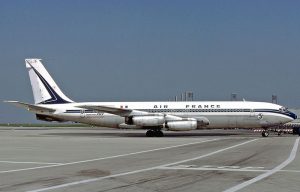 On June 22, 1962, an Air France Boeing 707 crashed on the island of Guadeloupe, killing all 113 passengers and crew members aboard. It was one of five major accidents involving Boeing 707s during that year. In all, the five crashes that year killed 457 people. Crashes happen, and unfortunately, they are not always such an unusual occurrence. Nevertheless, there was a mystery involved here. The Boeing 707 was originally a KC-135 military tanker and bomber. Boeing later decided to modify it to be used for civilian transport, and the finished product was the Boeing 707. The new design proved very popular in the commercial aviation industry. The Boeing 707 was not a fuel efficient as some of the other planes of that era, but it was faster than any other commercial jet at that time, so it made up for the fuel problem with its greater speed.
On June 22, 1962, an Air France Boeing 707 crashed on the island of Guadeloupe, killing all 113 passengers and crew members aboard. It was one of five major accidents involving Boeing 707s during that year. In all, the five crashes that year killed 457 people. Crashes happen, and unfortunately, they are not always such an unusual occurrence. Nevertheless, there was a mystery involved here. The Boeing 707 was originally a KC-135 military tanker and bomber. Boeing later decided to modify it to be used for civilian transport, and the finished product was the Boeing 707. The new design proved very popular in the commercial aviation industry. The Boeing 707 was not a fuel efficient as some of the other planes of that era, but it was faster than any other commercial jet at that time, so it made up for the fuel problem with its greater speed.
The airport on the island of Guadeloupe is located in a valley that is surrounded by mountains. Guadeloupe is a part of the French West Indies,located in the Caribbean. This particular airport is not the pilots favorite, because it requires them to make a steep descent just prior to landing. Any problem that occurs in the descent, is very hard to correct, because there is just no time. On June 22, the Air France flight failed to descend correctly and crashed directly into a peak call Dos D’Ane, or the Donkey’s Back. The plane exploded in a fireball; there were no survivors. The flight occurred before the black box flight recorder was invented, so no sure reason for the crash was ever officially found.
This crash was the third deadly crash of a Boeing 707 in a month, so something had to be done. On May 22nd, 45 people died when a plane went down in Missouri and on June 3rd, another Air France 707 crashed in Paris killing 130 people. No evidence was ever found that connected the accidents. It is believed that the weather played a part in the June 22, 1962 crash. The weather was poor in Guadeloupe that day. A violent thunderstorm was in the area, with a low cloud ceiling. Adding to the problem, the VOR navigational beacon 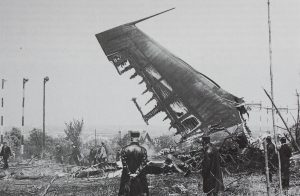 was out of service. The crew reported themselves over the non-directional beacon (NDB) at 5,000 feet and turned east to begin the final approach. That was the last time that anything was “normal” with the flight. Due to incorrect automatic direction finder (ADF) readings caused by the thunderstorm, the plane strayed 9.3 mile west from the procedural let-down track. Moments later, the plane crashed in a forest on the hill called Dos D’Ane, at about 1,400 feet and then exploded. There were no survivors. Among the dead was French Guianan politician and war hero Justin Catayée and poet and black-consciousness activist Paul Niger. While weather played a significant part in the crash, it was not the only cause.
was out of service. The crew reported themselves over the non-directional beacon (NDB) at 5,000 feet and turned east to begin the final approach. That was the last time that anything was “normal” with the flight. Due to incorrect automatic direction finder (ADF) readings caused by the thunderstorm, the plane strayed 9.3 mile west from the procedural let-down track. Moments later, the plane crashed in a forest on the hill called Dos D’Ane, at about 1,400 feet and then exploded. There were no survivors. Among the dead was French Guianan politician and war hero Justin Catayée and poet and black-consciousness activist Paul Niger. While weather played a significant part in the crash, it was not the only cause.
 Stagecoach drivers like Charley Parkhurst were tough as nails. Not everyone could handle a stagecoach. The stagecoach driver was respected…sometimes even more than was the millionaire statesman who might be riding beside him, or anyone else who had been given that honor. Parkhurst had been through the good times and bad times of driving stagecoach. Twice, Charley was held up. The first time, he was forced to throw down his strongbox because he was unarmed. The second time, he was prepared. When a road agent ordered the stage to stop and commanded Charley to throw down its strongbox, Parkhurst leveled a shotgun blast into the chest of the outlaw, whipped his horses into a full gallop, and left the bandit in the road.
Stagecoach drivers like Charley Parkhurst were tough as nails. Not everyone could handle a stagecoach. The stagecoach driver was respected…sometimes even more than was the millionaire statesman who might be riding beside him, or anyone else who had been given that honor. Parkhurst had been through the good times and bad times of driving stagecoach. Twice, Charley was held up. The first time, he was forced to throw down his strongbox because he was unarmed. The second time, he was prepared. When a road agent ordered the stage to stop and commanded Charley to throw down its strongbox, Parkhurst leveled a shotgun blast into the chest of the outlaw, whipped his horses into a full gallop, and left the bandit in the road.
Charley Parkhurst was one of the more skillful stagecoach drivers, not only in  California, but throughout the west. He was often called “One-eyed” or “Cockeyed” Charley, because he had lost an eye when kicked by a horse. He drove a stagecoach in California for 20 years. One-eyed Charley was known as one of the toughest, roughest, and the most daring of all stagecoach drivers. Like most drivers, he was proud of his skill in the extremely difficult job as “whip.” A “whip” is what stagecoach drivers were often called. Proper handling of the horses and the great coaches was an art that required much practice, experience, and not the least, courage. Whips received high salaries for the times, sometimes as much as $125 a month, plus room and board. While most stage drivers were sober, at least while on duty, nearly all were fond of an occasional “eye opener.” A good driver was the captain of his craft. His timid passengers feared him. He was
California, but throughout the west. He was often called “One-eyed” or “Cockeyed” Charley, because he had lost an eye when kicked by a horse. He drove a stagecoach in California for 20 years. One-eyed Charley was known as one of the toughest, roughest, and the most daring of all stagecoach drivers. Like most drivers, he was proud of his skill in the extremely difficult job as “whip.” A “whip” is what stagecoach drivers were often called. Proper handling of the horses and the great coaches was an art that required much practice, experience, and not the least, courage. Whips received high salaries for the times, sometimes as much as $125 a month, plus room and board. While most stage drivers were sober, at least while on duty, nearly all were fond of an occasional “eye opener.” A good driver was the captain of his craft. His timid passengers feared him. He was  held in awe by stable boys, and was the trusty agent of his employer…and Charley was the best.
held in awe by stable boys, and was the trusty agent of his employer…and Charley was the best.
Nevertheless, little was really known about Charley Parkhurst before or after he came to California. It wasn’t until his body was prepared for burial that his true secret was discovered. Charlotte “Charley” Parkhurst was a woman. One doctor claimed that at some point in her life, she had been a mother. Unknowingly, Parkhurst could claim a national first. After voting on Election Day, November 3, 1868, Charley was probably the first woman to cast a ballot in any election. It wasn’t until 52 years later that the right to vote was guaranteed to women by the nineteenth amendment.
 On April 10, 1912, Titanic set sail from Southampton. Titanic called at Cherbourg in France and Queenstown (now Cobh) in Ireland before heading west to New York. For the passengers and crew, Titanic was the ultimate in luxury, and to be on it was the ultimate thrill. The ship was the most luxurious ship of its day, and to add to their sense of excitement, it was unsinkable. The passengers were assured that the ship had so many fail-safes in place that the builders didn’t even think the lifeboats were necessary, and any that were considered to be in the way, were removed, in what would prove to be a fatal mistake. In the end, there were 20 lifeboats on board the ship, when she was supposed to have 64 lifeboats. Each had a capacity of 65 people. Most lifeboats were lowered to the water with less than half their actual capacity.
On April 10, 1912, Titanic set sail from Southampton. Titanic called at Cherbourg in France and Queenstown (now Cobh) in Ireland before heading west to New York. For the passengers and crew, Titanic was the ultimate in luxury, and to be on it was the ultimate thrill. The ship was the most luxurious ship of its day, and to add to their sense of excitement, it was unsinkable. The passengers were assured that the ship had so many fail-safes in place that the builders didn’t even think the lifeboats were necessary, and any that were considered to be in the way, were removed, in what would prove to be a fatal mistake. In the end, there were 20 lifeboats on board the ship, when she was supposed to have 64 lifeboats. Each had a capacity of 65 people. Most lifeboats were lowered to the water with less than half their actual capacity.
The night of April 14, 1912 was very cold, and the route Titanic was on was littered with icebergs. Other ships 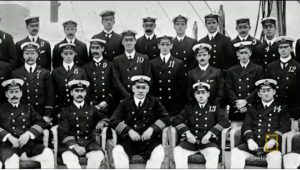 in the area tried to warn Titanic, but the radio operator of Titanic did not take the warnings seriously. He was operating under the mistaken idea that Titanic could sail right through any ice field she might come upon, and have no problems whatsoever. The radio operator was wrong. Nevertheless, he shut of the radio after the 6th warning transmission. The iceberg strike came at 11:40 pm…but the first distress call was sent almost an hour later and even then the ships receiving the calls could did not believe it could be real. Finally, at 12:40 am, Carpathia’s radio operator gave the call to head for Titanic’s last known position.
in the area tried to warn Titanic, but the radio operator of Titanic did not take the warnings seriously. He was operating under the mistaken idea that Titanic could sail right through any ice field she might come upon, and have no problems whatsoever. The radio operator was wrong. Nevertheless, he shut of the radio after the 6th warning transmission. The iceberg strike came at 11:40 pm…but the first distress call was sent almost an hour later and even then the ships receiving the calls could did not believe it could be real. Finally, at 12:40 am, Carpathia’s radio operator gave the call to head for Titanic’s last known position.
Help would come too late for Titanic. By 2:20 am on April 15, 1912, Titanic sank, but she was not without her heroes. As the Titanic was sinking, the deck crew began loading passengers onto lifeboats. The engineering crew stayed at their posts to work the pumps, controlling flooding as much as possible. This action ensured the 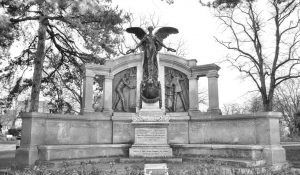 power stayed on during the evacuation and allowed the wireless radio system to keep sending distress calls. These men bravely kept at their work and helped save more than 700 people…even though it would cost them their own lives. When Titanic went down, she took with her 1500 people. of those, 688 were crew members, including all 25 of the engineers who worked tirelessly, at their own peril to buy what little bit of time they could for the passengers in their care. Many of the crew members forfeited their lives so that the passengers might live. Were serious mistakes made…yes, of course, but by the same token, the sinking of Titanic saw some of the most amazing bravery ever.
power stayed on during the evacuation and allowed the wireless radio system to keep sending distress calls. These men bravely kept at their work and helped save more than 700 people…even though it would cost them their own lives. When Titanic went down, she took with her 1500 people. of those, 688 were crew members, including all 25 of the engineers who worked tirelessly, at their own peril to buy what little bit of time they could for the passengers in their care. Many of the crew members forfeited their lives so that the passengers might live. Were serious mistakes made…yes, of course, but by the same token, the sinking of Titanic saw some of the most amazing bravery ever.
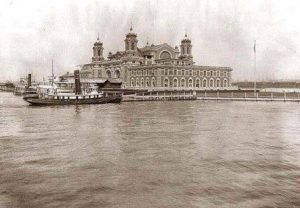 A number of my ancestors came to America during and prior to the years that Ellis Island was the processing center in New York. I have no doubt that some of them came through Ellis Island, but I have not confirmed that. I find many of the names in my tree, but while many of the ancestors I have found came over by way of New York, it would appear that my direct line arrived in America before the immigration center at Ellis Island opened on January 2, 1892. Before that time, immigrants were handled by the individual states where the immigrant first arrived. It is estimated that about 40% of Americans can trace their roots through Ellis Island, so while I see many familiar names, they may or may not be my direct line, and in fact, they might not be related at all.
A number of my ancestors came to America during and prior to the years that Ellis Island was the processing center in New York. I have no doubt that some of them came through Ellis Island, but I have not confirmed that. I find many of the names in my tree, but while many of the ancestors I have found came over by way of New York, it would appear that my direct line arrived in America before the immigration center at Ellis Island opened on January 2, 1892. Before that time, immigrants were handled by the individual states where the immigrant first arrived. It is estimated that about 40% of Americans can trace their roots through Ellis Island, so while I see many familiar names, they may or may not be my direct line, and in fact, they might not be related at all.
Ellis Island is located in New York Harbor off the New Jersey coast and was named for merchant Samuel Ellis, who owned the land in the 1770s. The island was given the nickname, The Gateway to America because more than 12 million immigrants passed through the center since it opened in 1892. On January 2, 1892, 15 year old Annie Moore, from Ireland, became the first person to pass through the newly opened Ellis Island, which President Benjamin Harrison designated as America’s first federal immigration center in 1890. Oddly, not all 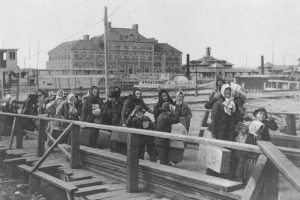 immigrants who sailed into New York had to go through Ellis Island. First and second class passengers were just given a brief shipboard inspection and then disembarked at the piers in New York or New Jersey, where they passed through customs. People in third class, though, were transported to Ellis Island, where they underwent medical and legal inspections to ensure they didn’t have a contagious disease or some condition that would make them a burden to the government. Nevertheless, only two percent of all immigrants were denied entrance into the United States. The peak years of immigration through Ellis Island were from 1892 to 1924. The 3.3 acre island was enlarged by landfill, and by the 1930s, it had reached its current size of 27.5 acres. After the extra size was completed, new buildings were constructed to handle the massive influx of people coming to America for a better life. During it’s busiest year, which was 1907, over 1 million people were processed through Ellis Island.
immigrants who sailed into New York had to go through Ellis Island. First and second class passengers were just given a brief shipboard inspection and then disembarked at the piers in New York or New Jersey, where they passed through customs. People in third class, though, were transported to Ellis Island, where they underwent medical and legal inspections to ensure they didn’t have a contagious disease or some condition that would make them a burden to the government. Nevertheless, only two percent of all immigrants were denied entrance into the United States. The peak years of immigration through Ellis Island were from 1892 to 1924. The 3.3 acre island was enlarged by landfill, and by the 1930s, it had reached its current size of 27.5 acres. After the extra size was completed, new buildings were constructed to handle the massive influx of people coming to America for a better life. During it’s busiest year, which was 1907, over 1 million people were processed through Ellis Island.
When the United States entered into World War I, immigration to the United States decline, most likely because travel anywhere was risky. Ellis Island was used as a detention center for suspected enemies during that time. Following the war, Congress passed quota laws and the Immigration Act of 1924, which sharply reduced the number of newcomers allowed into the country and also enabled immigrants to be processed at United States 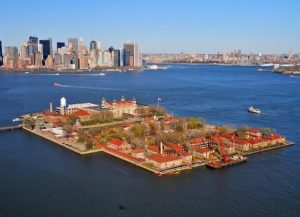 consulates abroad. The act also enabled immigrants to be processed at United States consulates abroad, making detention at Ellis Island obsolete. After 1924, Ellis Island switched from a processing center to other purposes, such as a detention and deportation center for illegal immigrants, a hospital for wounded soldiers during World War II and a Coast Guard training center. In November 1954, the last detainee, a Norwegian merchant seaman, was released and Ellis Island officially closed on November 12, 1954. In 1984, Ellis Island underwent a $160 million renovation, the largest historic restoration project in United States history. In September 1990, the Ellis Island Immigration Museum opened to the public and is visited by almost 2 million people each year.
consulates abroad. The act also enabled immigrants to be processed at United States consulates abroad, making detention at Ellis Island obsolete. After 1924, Ellis Island switched from a processing center to other purposes, such as a detention and deportation center for illegal immigrants, a hospital for wounded soldiers during World War II and a Coast Guard training center. In November 1954, the last detainee, a Norwegian merchant seaman, was released and Ellis Island officially closed on November 12, 1954. In 1984, Ellis Island underwent a $160 million renovation, the largest historic restoration project in United States history. In September 1990, the Ellis Island Immigration Museum opened to the public and is visited by almost 2 million people each year.
 In their early years, the railroads were quite powerful companies, and with good reason. The railroad reduced travel time across the United States from days or months, to hours, in many cases. They brought supplies, payroll, and people from back east to the west quickly. The railroad did not come without some confusion, however. Even as late as the 1880s, most United States towns had their own system for keeping track of time, based on where the sun was at high noon. I had never given much thought to this, but I suppose it could have been a big mess, since the train’s arrival would be very mixed up, and the end result would be that the train might be scheduled to arrive in several places at once.
In their early years, the railroads were quite powerful companies, and with good reason. The railroad reduced travel time across the United States from days or months, to hours, in many cases. They brought supplies, payroll, and people from back east to the west quickly. The railroad did not come without some confusion, however. Even as late as the 1880s, most United States towns had their own system for keeping track of time, based on where the sun was at high noon. I had never given much thought to this, but I suppose it could have been a big mess, since the train’s arrival would be very mixed up, and the end result would be that the train might be scheduled to arrive in several places at once.
Because the railroads were quite powerful, they took it upon themselves to make a monumental change that would affect the entire nation, and Canada too. At exactly noon on this day in 1883, American and Canadian railroads broke the continent into four sections, and began using a system of time zones that we still use to this day, with very few changes made to it over the years. I’m sure there were people who did not like the new system much, but most people quickly embraced it, because their lives depended on the railroad in one way or another. The root of the problem they had was that they moved passengers and freight over the thousands of miles the line covered. With the varying times in towns along the route, the train 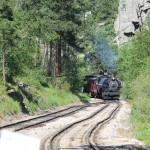 ended up with dozens of different departure and arrival times. No one really knew when the train would arrive…except possibly the engineer. I’m sure that caused chaos in the train stations…especially in the bigger cities. These days, we have to be at the airport two hours early for flights, because of screening, so imagine that kind of a scenario in the small train stations of the old west. This scheduling nightmare had to be stopped, and time zones were the only logical way to do it.
ended up with dozens of different departure and arrival times. No one really knew when the train would arrive…except possibly the engineer. I’m sure that caused chaos in the train stations…especially in the bigger cities. These days, we have to be at the airport two hours early for flights, because of screening, so imagine that kind of a scenario in the small train stations of the old west. This scheduling nightmare had to be stopped, and time zones were the only logical way to do it.
With the use of time zones, rail transportation became far more efficient. The thing that seems rather odd, is that they didn’t go to the United States or Canadian governments to resolve the problem, and if the government at that time was as inefficient as our congress is right now, I can fully understand why they didn’t. Imaging waiting six years to make a decision concerning time and its vital role in rail travel. Something had to be done right away, and the railroad was just bold enough to do it. As it turned out, no one tried to stop them either. I suppose everyone could see just how logical their plan was, and no one complained. So, the railroad companies agreed to create four continental time zones, and that decision has changed the way we live to this day.
The lines they adopted to make those time zones were very close to the ones we have today. I’m sure that any changes are based on where towns began to fall along the zone lines. It wasn’t until as late as 1918 that Congress officially adopted the railroad time zones and put them under the Interstate Commerce Commission.  Just imagine, if you will, if the people and the railroad had waited for Congress to act on this matter. There would have been 35 more years of unorganized and frustrating railroad travel. Something that should have revolutionized travel, would have been relegated to the stone age again, because of Congress’ lack of action. Even after the system was implemented and people finally had an organized schedule, that was relatively accurate…because you can’t predict accidents or weather related delays very well, Congress sat on their hands, and I suppose they operated the government on government time instead. In this writer’s opinion, the time zones were a wonderful idea, and have benefitted this nation very well since 1883. My family has a long history of working on the railroad, and that is a fact that I am very proud of.
Just imagine, if you will, if the people and the railroad had waited for Congress to act on this matter. There would have been 35 more years of unorganized and frustrating railroad travel. Something that should have revolutionized travel, would have been relegated to the stone age again, because of Congress’ lack of action. Even after the system was implemented and people finally had an organized schedule, that was relatively accurate…because you can’t predict accidents or weather related delays very well, Congress sat on their hands, and I suppose they operated the government on government time instead. In this writer’s opinion, the time zones were a wonderful idea, and have benefitted this nation very well since 1883. My family has a long history of working on the railroad, and that is a fact that I am very proud of.
 In times past…long before the Cruise Craze occurred, the average person didn’t really travel by ship. Immigrants did, but mostly they spent their entire life’s savings to make the journey to a new country, and often they traveled in the steerage class…without all the amenities of the people in 1st class. As we saw on the movie Titanic, the 1st class passengers were treated like royalty, because they had a lot of money, while the others were kept separate…like they might rub off on the 1st class passengers, or get them dirty or something.
In times past…long before the Cruise Craze occurred, the average person didn’t really travel by ship. Immigrants did, but mostly they spent their entire life’s savings to make the journey to a new country, and often they traveled in the steerage class…without all the amenities of the people in 1st class. As we saw on the movie Titanic, the 1st class passengers were treated like royalty, because they had a lot of money, while the others were kept separate…like they might rub off on the 1st class passengers, or get them dirty or something.
These days, the rich and famous don’t exactly take cruises. If they want to cruise, the get a yacht or they just fly to where they want to go, often in their own plane. If they are on a cruise ship, then they are really traveling incognito, because I have not 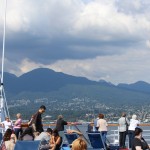 noticed anyone rich or famous on my two cruises. Mostly I think that the cruise vacation gives the middle class citizen the chance to live like a king for a few days, and forget their problems for a while.
noticed anyone rich or famous on my two cruises. Mostly I think that the cruise vacation gives the middle class citizen the chance to live like a king for a few days, and forget their problems for a while.
On the cruises I have taken, as well as the ones my family has taken, there are people from all walks of life, sharing this space and the amenities it offers for a little time of respite from their day to day working lives. And how cool is that!! There is no snobbery, and no special place to dine that only the rich can go. Everyone is treated like royalty. Although, unless you get a balcony room, there is one deck you don’t have access to. No great loss, if you ask me.
I find that quite refreshing really. So often, we are placed in classes, whether we like it or not. You can play golf and the club…if 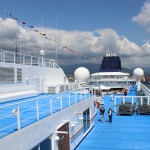 you can afford the fees. You can belong to this or that club…again, if you can afford it. And it is true that the people on a cruise ship must be able to afford the cost, but there are ways to keep the cost down and still have an amazing time. It is something you can save up for, and take your own opportunity to live like kings for a little while.
you can afford the fees. You can belong to this or that club…again, if you can afford it. And it is true that the people on a cruise ship must be able to afford the cost, but there are ways to keep the cost down and still have an amazing time. It is something you can save up for, and take your own opportunity to live like kings for a little while.
I think everyone should try this type of trip when they can. It gives you an opportunity to let someone else wait on you for a while, and all you do is sit back and enjoy the ride. It is such a great way to de-stress, and don’t we all need that once in a while? I know I do. Give it a try. It’s great to live like kings…even if it’s only temporary.
 As a kid, I was probably…different than lots of other kids. While most of my friends were listening to rock and roll, I was too, but I also liked things that were different, like Jonathan Livingston Seagull, by Richard Bach. When Neil Diamond did his narration, I found the story line very fascinating. Here was a seagull that wanted something different from life. He didn’t want the boring everyday existence, but the extraordinary. That was how I felt. It was quite easy to relate to Jonathan’s desire for excellence and yes, even greatness. He wanted to be remembered for doing something different, and like most pioneers, he was not appreciated for his efforts. The flock was disgusted with him, and threatened to throw him out. His parents were humiliated…horrified even, that their son wanted to be so different. That could sound like lots of parents today, but thankfully not my own, who wanted their daughters to be whatever they chose to be.
As a kid, I was probably…different than lots of other kids. While most of my friends were listening to rock and roll, I was too, but I also liked things that were different, like Jonathan Livingston Seagull, by Richard Bach. When Neil Diamond did his narration, I found the story line very fascinating. Here was a seagull that wanted something different from life. He didn’t want the boring everyday existence, but the extraordinary. That was how I felt. It was quite easy to relate to Jonathan’s desire for excellence and yes, even greatness. He wanted to be remembered for doing something different, and like most pioneers, he was not appreciated for his efforts. The flock was disgusted with him, and threatened to throw him out. His parents were humiliated…horrified even, that their son wanted to be so different. That could sound like lots of parents today, but thankfully not my own, who wanted their daughters to be whatever they chose to be.
I have always loved to watch seagulls. Most of the ones I could watch…around the fast food joints in Casper, Wyoming, were of the same old boring race for food variety, but when you get out on the ocean…and watch them from a ship, it’s a very different thing indeed. Those  birds, much like Jonathan Livingston Seagull enjoy flying for the pure enjoyment of flight. I love watching them soar and glide across the sky and swoop down to glide just above the face of the water. As we sailed along, they keep the pace with the ship, almost like they are trying to stay close to the people on board. These were gulls who were doing un-gull-like things. Now, I know that none of these gulls was the famous Jonathan Livingston Seagull, but I have to think that one or two of them might be aspiring to be the next Jonathan Livingston Seagull. Maybe even a modern day Jonathan Livingston Seagull, who maybe goes by John Seagull, because those full names are so stuffy anyway.
birds, much like Jonathan Livingston Seagull enjoy flying for the pure enjoyment of flight. I love watching them soar and glide across the sky and swoop down to glide just above the face of the water. As we sailed along, they keep the pace with the ship, almost like they are trying to stay close to the people on board. These were gulls who were doing un-gull-like things. Now, I know that none of these gulls was the famous Jonathan Livingston Seagull, but I have to think that one or two of them might be aspiring to be the next Jonathan Livingston Seagull. Maybe even a modern day Jonathan Livingston Seagull, who maybe goes by John Seagull, because those full names are so stuffy anyway.
There were lots of seagulls on our trip…the kind who went out by the fishing boats hoping for scraps of food, of course. There were also the ones who hunted for their own food, gliding low over the water, and then swooping down into the water hoping to catch their prey. They even hung out around the whales, although I have no idea what they were hoping to gain by that. Perhaps they thought the whales might stir up the fish, bringing them to the surface for easier hunting. While these gulls were doing what normal gulls do…hunting for food. They were not extraordinary and they were certainly not unique.

The gulls that loved flight were something so different, however. Yes, they swooped into the water for food too, but it did not seem to be the only thing they cared about. Watching them soar across the sky, or try to keep up with the ship, holding their position so they could look into the windows at the passengers, was so interesting. You would think that the ship, or at least the passengers would scare the birds, but they seem drawn to them. It’s almost like they are showing off. Like Jonathan Livingston Seagull, they seem to be shooting for something outside the norm. And that is what draws my attention to them too.
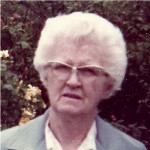 My Great Aunt Gladys, passed away on July 19, 1989. She was a passenger on United Airlines Flight 232, which crashed at Sioux Gateway Airport in Sioux City, Iowa. It was a crash I’m sure many of you will remember. According to the pilot on that flight, Captain Al Haynes a veteran pilot with 30,000 hours of flying time, “When the #2 hydraulics on the DC-10 blew, or when the #2 engine blew, it took out the #2 accessory drive section, which took out the hydraulics for the #2 system. And some 70 pieces of shrapnel penetrated the horizontal stabilizer and severed the #1 line and the #3 line, and as a result we ended up with no hydraulics.”
My Great Aunt Gladys, passed away on July 19, 1989. She was a passenger on United Airlines Flight 232, which crashed at Sioux Gateway Airport in Sioux City, Iowa. It was a crash I’m sure many of you will remember. According to the pilot on that flight, Captain Al Haynes a veteran pilot with 30,000 hours of flying time, “When the #2 hydraulics on the DC-10 blew, or when the #2 engine blew, it took out the #2 accessory drive section, which took out the hydraulics for the #2 system. And some 70 pieces of shrapnel penetrated the horizontal stabilizer and severed the #1 line and the #3 line, and as a result we ended up with no hydraulics.”
It was a situation that had a 1 in 1 billion chance of happening, but on July 19, 1989, on United Airlines Fight 232 which had taken off from Stapleton International Airport in Denver, Colorado, bound for Chicago, Illinois with 296 souls on board, one of which was my Great Aunt Gladys, it did happen. Of the 285 passengers and 11 crew members, 184 people would survive the subsequent crash of United Airlines Flight 232…sadly, my Great Aunt Gladys was not one of them. The airline was having a special that day, in which children flying with a parent flew for half price. That special put an unusually large number of children on the flight…52 to be exact. A number of those kids were traveling alone. Four children were “lap” children…children without a seat of their own. Eleven children, including 1 “lap” child died in the disaster.
The passengers on board the flight knew they were in trouble for 45 minutes before the crash. I have often thought about what my Aunt Gladys was thinking about during those 45 minutes. Her family, of course…hoping she would be able to return home to see them again. Worry and fear must have entered in, and it makes me so sad to think that her last minutes were spent in such a manner. My mom said something to me after we found out that she had not survived, that makes me think that she was thinking of one other thing…the children. Mom said that Aunt Gladys would have wanted the children to survive, because they had not had a chance at life yet. I think that is true, because Aunt Gladys was always so sweet to the children. She never said one harsh word to me or my sisters…even when we wanted to play with her Avon products or touch her silk nylons, because they were so soft.
During the crash, the plane cartwheeled, and possessions where thrown all over the  place. So came about the misinformation that made us believe that Aunt Gladys had survived. Her purse went to the hospital with another woman. Upon further investigation, they would find that it was not my aunt, but not before the news media had listed her as a survivor. It was not their fault, but nevertheless heartbreaking to our family. Today marks the 23rd anniversary of the crash of United Flight 232 in Sioux City, Iowa, and the subsequent loss of my dear Great Aunt Gladys. Sometimes, when I see a woman who resembles her, my heart still jumps, because it’s almost like she is still here. I suppose that happens because we could not view her body, and maybe that isn’t the worst thing. At least we can still imagine her among the living. We love and still miss you Aunt Gladys.
place. So came about the misinformation that made us believe that Aunt Gladys had survived. Her purse went to the hospital with another woman. Upon further investigation, they would find that it was not my aunt, but not before the news media had listed her as a survivor. It was not their fault, but nevertheless heartbreaking to our family. Today marks the 23rd anniversary of the crash of United Flight 232 in Sioux City, Iowa, and the subsequent loss of my dear Great Aunt Gladys. Sometimes, when I see a woman who resembles her, my heart still jumps, because it’s almost like she is still here. I suppose that happens because we could not view her body, and maybe that isn’t the worst thing. At least we can still imagine her among the living. We love and still miss you Aunt Gladys.

